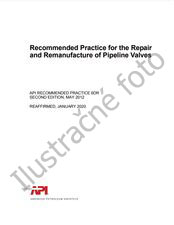Potrebujeme váš súhlas na využitie jednotlivých dát, aby sa vám okrem iného mohli ukazovať informácie týkajúce sa vašich záujmov. Súhlas udelíte kliknutím na tlačidlo „OK“.

API MPMS 8.5-ed.2
Manual of Petroleum Measurement Standards Chapter 8.5 Standard Practice for Manual Piston Cylinder Sampling for Volatile Crude Oils, Condensates, and Liquid Petroleum Products
NORMA vydaná dňa 1.9.2022
Informácie o norme:
Označenie normy: API MPMS 8.5-ed.2
Dátum vydania normy: 1.9.2022
Kód tovaru: NS-1139664
Počet strán: 21
Približná hmotnosť: 63 g (0.14 libier)
Krajina: Americká technická norma
Kategória: Technické normy API
Anotácia textu normy API MPMS 8.5-ed.2 :
API MPMS 8.5, 2nd Edition, September 2022 - Manual of Petroleum Measurement Standards Chapter 8.5 Standard Practice for Manual Piston Cylinder Sampling for Volatile Crude Oils, Condensates, and Liquid Petroleum Products
This practice includes the equipment and procedures for obtaining a representative sample of “live” or high vapor pressure crude oils, condensates, and/or liquid petroleum products from low pressure sample points, where there is insufficient sample point pressure to use a Floating Piston Cylinder (FPC) as described in Practice D3700.
This practice is intended for use with sample types, such as UN Class 3 Flammable Liquids, that might have been collected and transported using open containers. The use of a manual piston cylinder in place of open containers is intended to prevent the loss of volatile (light end) components, which can impact subsequent test results.
This practice is suitable for sampling crude oils, condensates, and/or liquid petroleum products having true vapor pressures less than 300 kPa (43 psia nominal) at 50 °C. This practice applies to samples that will typically fall between Practices D4057 (API MPMS Chapter 8.1) and D3700. This practice shall not be used for materials classified as UN Class 2 Gases2 (“…having a vapor pressure greater than 300 kPa at 50 °C or is completely gaseous at 20 °C at 101.3 kPa.”).
This practice allows for sampling of crude oils that flow freely at the conditions of sampling.
It is the responsibility of the user to ensure that the sampling point is located so as to obtain a representative sample.
The values stated in SI units are to be regarded as standard.
Exception—
The values given in parentheses are for information only.
This standard does not purport to address all of the safety concerns, if any, associated with its use. It is the responsibility of the user of this standard to establish appropriate safety, health, and environmental practices and determine the applicability of regulatory limitations prior to use.
This international standard was developed in accordance with internationally recognized principles on standardization established in the Decision on Principles for the Development of International Standards, Guides and Recommendations issued by the World Trade Organization Technical Barriers to Trade (TBT) Committee.
2 UN Recommendations of the Transportation of Dangerous Goods, Chapter 2.2.1.1.
*A Summary of Changes section appears at the end of this standard



 Cookies
Cookies
